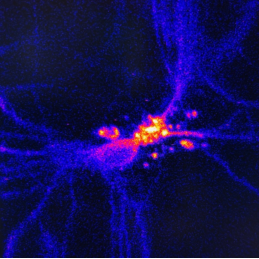Laser development
Here you will find all projects and funding that deal with the research and development of novel laser light sources.
weave ADAPT
Development of a new pulsed laser source at 940 nm for 940SLIDE
The innovative imaging method SLIDE (Spectro-temporal Laser Imaging by Diffracted Excitation) makes it possible to record the physiological activity of active neurons in living tissue thanks to its impressively fast frame rate in the kilohertz range. The calcium indicator GCaMP is frequently used in research to record neuronal activity. The indicator is sensitive to changes in calcium concentration, which is linked to the membrane potential of neurons. To maximize imaging quality based on this calcium-sensitive staining, a new light source tuned to the two-photon excitation of GCaMP is required.
Our current research project focuses on enabling SLIDE imaging at this new wavelength by implementing an excitation source at 940 nm.
For this purpose, we are pursuing different approaches taking advantage of various effects. Using Stimulated Raman Scattering, Four-Wave Mixing and broadband frequency doubling by a FAN-OUT PPLN crystal, we aim to optimize SLIDE imaging at 940 nm and thus open up new possibilities for the study of neuronal activity in living tissue.
SWEEPICS
Pulsed swept-source lasers in the visible and NIR spectral region
The EU project SWEEPICS (www.sweepics.eu) is an interdisciplinary research project with a consortium of 9 scientific partners. The aim is to investigate new coherent swept-source lasers that provide high-intensity pulses at 488nm, 532nm, 976nm and 1064nm and then apply them in multiphoton microscopy and optoacoustics. In addition, a commercial pulsed FDML laser is being developed in collaboration with the company Optores. This new laser will also provide the capability of a pulse-on-demand functionality. This flexibility will enable a “smart FDML-MOPA” laser, that is operated in conjunction with an AI-controlled microscope. The idea is to create a control loop for smart microscopy, where an AI-based image analysis operator can control the laser and microscope acquisition parameters to achieve improved and better microscopy images.













